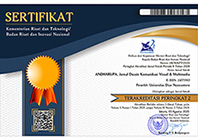Pengembangan Motif Tenun Troso Berbasis Komputer Grafis
DOI:
https://doi.org/10.33633/andharupa.v5i01.2022Abstract
Abstrak Tenun Troso merupakan kerajinan Tenun ikat tradisional khas Jepara. Industri Tenun Troso kini makin berkembang, produknya tersebar di berbagai kota seperti Jakarta, Lombok, Nusa Tenggara Barat, Nusa Tenggara Timur, dan Bali. Namun para pengrajin Tenun Troso kini lebih mengutamakan aspek dagang, yang mana motif tenun dibuat sesuai dengan permintaan konsumen, sehingga bentuk motif selalu berubah dan tidak memiliki ciri khas yang identik dengan wilayah Jepara. Oleh sebab itu penelitian ini bertujuan untuk menghasilkan motif Tenun Troso yang sesuai ciri khas potensi wilayah Jepara dengan pengolahan komputer grafis. Metode yang digunakan dalam penelitian ini adalah metode kualitatif dengan pendekatan penciptaan seni yang terdiri dari tahap eksplorasi, perancangan, dan perwujudan karya. Hasil dari penelitian ini adalah motif yang dihasilkan dapat gunakan sebagai acuan bagi para pengrajin Tenun Troso. Kata Kunci: Jepara, komputer grafis, motif, Tenun Troso  Abstrak Tenun Troso is a traditional tie weaving craft typically from Jepara. Now, Tenun Troso industry is growing. The product is spread in various cities, for example, Jakarta, Lombok, Nusa Tenggara Barat, Nusa Tenggara Timur, and Bali. However, the craftsmen of Tenun Troso is prioritizing more on trade aspect, which weaving motif made by corresponding with consumer demand. As the result, the motif is always changing and don’t have an identical characteristic with Jepara region. Therefore, the aim of this research is to produce Troso weaving motif that is consistent with the potential characteristics of the Jepara region by computer graphics processing. The method used in this research is qualitative methods with an art creation approach consisting of exploration, design, and creation of works phase. The result of this research is to produce the design that can be used as a reference for Tenun Troso craftsmen. Keywords: computer graphic, Jepara, motif , Tenun TrosoReferences
Azizah, Z. D. (2015). Deformasi Flora dan Fauna Dalam Motif Batik pada Pembelajaran Seni Budaya Kelas VIIIC SMPN 1 Turi. Yogyakarta.
Gustami, S. (2000). Seni Kerajinan Mebel Ukir Jepara : Kajian Estetika Melalui Pendekatan Multidisiplin. Yogyakarta: Penerbit Kanisius.
Gustami, S. (2007). Butir-Butir Mutiara Estetika Timur: Ide Dasar Penciptaan Seni Kriya Indonesia. Yogyakarta: Prasista.
Kristiyani, D. (2014). Perancangan Kampanye Pengenalan Seni Ukir Jepara Kepada Anak Usia 9-12 Tahun di Kota Semarang. Universitas Kristen Maranatha.
Maki, T. (2002). Mastering Computer Graphic : untuk Pemula. Jakarta: Nexx media Inc.
Ramadhani, R. D., & S., S. (2016). KEBERADAAN DAN PERKEMBANGAN TENUN TROSO JEPARA. Ornamen Jurnal Kriya Seni ISI Surakarta, 12(1).
Sedyawati, E. (2007). Keindonesiaan dalam budaya. Jakarta: Wedatama Widya Sastra.
Setiawan, A., & Sulaiman, A. M. (2017). Pengembangan Desain Motif Ukir Untuk Aktualisasi Identitas Jepara Sebagai Kota Ukir. ANDHARUPA: Jurnal Desain Komunikasi Visual & Multimedia, 3(01), 31–48.
Soemardjan, S., & Soemardi, S. (1964). Setangkai Bunga Sosiologi. Jakarta: Jajasan Badan Penerbit Fakultas Ekonomi, Universitas Indonesia.
Downloads
Published
Issue
Section
License
Copyright (c) 2019 ANDHARUPA: Jurnal Desain Komunikasi Visual & Multimedia

This work is licensed under a Creative Commons Attribution 4.0 International License.
Authors who publish with this journal agree to the following terms:
- Authors retain copyright and grant the journal right of first publication with the work simultaneously licensed under a Creative Commons Attribution License that allows others to share the work with an acknowledgment of the work's authorship and initial publication in this journal.
- Authors are able to enter into separate, additional contractual arrangements for the non-exclusive distribution of the journal's published version of the work (e.g., post it to an institutional repository or publish it in a book), with an acknowledgment of its initial publication in this journal.
- Authors are permitted and encouraged to post their work online (e.g., in institutional repositories or on their website) prior to and during the submission process, as it can lead to productive exchanges, as well as earlier and greater citation of published work (See The Effect of Open Access).















